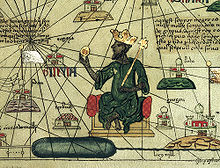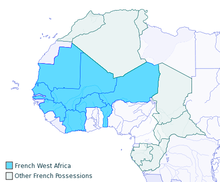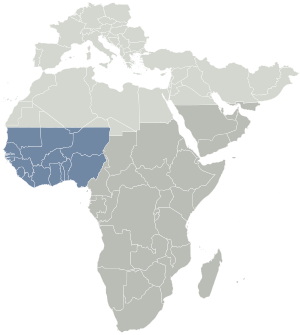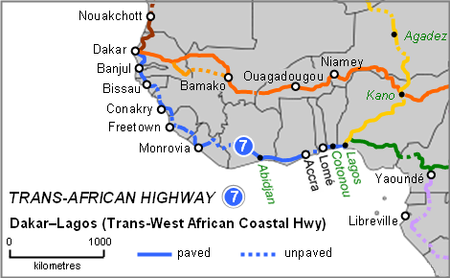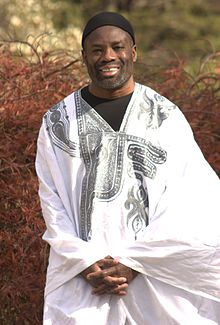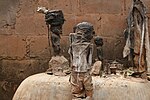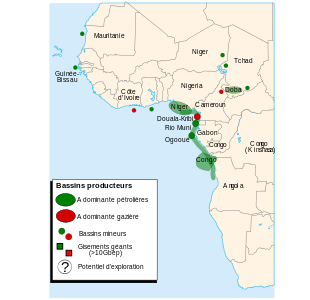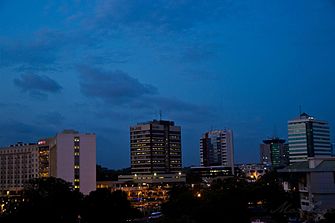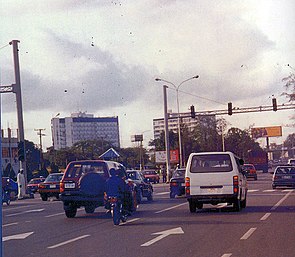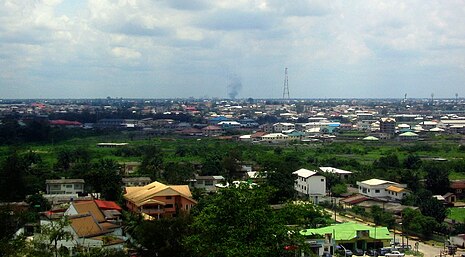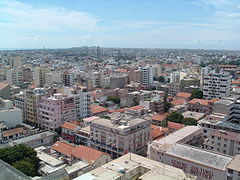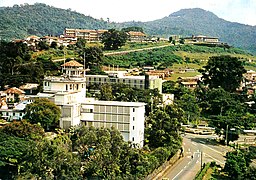West Africa
Jump to navigationJump to search
| West Africa | |
|---|---|
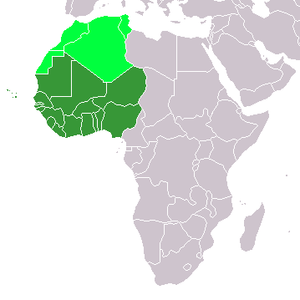
West Africa (UN subregion)
|
|
| Area | 5,112,903 km2 (1,974,103 sq mi) (7th) |
| Population | 381,202,440 (2018 est.) (3rd)[1][2] 381,981,000 (female: 189,672,000; male: 192,309,000 (2017 est.[3]) |
| Density | 49.2/km2 (127.5/sq mi) |
| Demonym | West African |
| Countries | |
| Time zones | UTC+0 to UTC+1 |
| Major Regional Organizations | Economic Community of West African States (ECOWAS; established 1975) |
| Total GDP (PPP) | US$752.983 billion (2013) (23rd)[4] |
| GDP (PPP) per capita | US$2,500 (2013)[5] |
| Total GDP (nominal) | US$655.93485 billion (2013)[6][7] |
| Total GDP (nominal) per capita | US$1,929.22 (2013)[6] |
| Currency | |
| Largest cities | Lagos, Nigeria Abidjan, Ivory Coast Accra, Ghana Abuja, Nigeria Kano, Nigeria Ibadan, Nigeria Kumasi, Ghana Port Harcourt, Nigeria |
| UN M.49 code | 011 – West Africa202 – Sub-Saharan Africa002 – Africa001 – World |
West Africa is the westernmost region of Africa. The United Nations defines Western Africa as the 16 countries of Benin, Burkina Faso, Cape Verde, The Gambia, Ghana, Guinea, Guinea-Bissau, Ivory Coast, Liberia, Mali, Mauritania, Niger, Nigeria, Senegal, Sierra Leone and Togo, as well as the United Kingdom Overseas Territory of Saint Helena, Ascension and Tristan da Cunha.[8] The population of West Africa is estimated at about 381 million[1][2] people as of 2018, and at 381,981,000 as of 2017, of which 189,672,000 are female and 192,309,000 male.[3]
List of countries[edit]
Genetic background[edit]
Map of early diversification of modern humans, with haplogroup L2 entering West Africa.
Studies of human mitochondrial DNA suggest that all humans share common ancestors from Africa, originated in the southwestern regions near the coastal border of Namibia and Angola at the approximate coordinates 12.5° E, 17.5°S with a divergence in the migration path around 37.5°E, 22.5°N near the Red Sea.[9]
A particular haplogroup of DNA, haplogroup L2, evolved between 87,000 and 107,000 years ago[10] or approx. 90,000 YBP.[11] Its age and widespread distribution and diversity across the continent makes its exact origin point within Africa difficult to trace with any confidence,[12] however an origin for several L2 groups in West or Central Africa seems likely,[12] with the highest diversity in West Africa. Most of its subclades are largely confined to West and western-Central Africa.[13]
Africans bearing the E-V38 (E1b1a) likely traversed across the Sahara, from east to west, approximately 19,000 years ago.[14] E-M2 (E1b1a1) likely originated in West Africa or Central Africa.[15]
Due to the large numbers of West Africans enslaved in the Atlantic slave trade, most African Americans, Afro Latin Americans and Black Caribbeans are likely to have mixed ancestry from different regions of western Africa.[16] 60% of African-Americans (in the study) were of the E1b1a haplogroup, within which 22.9% were particularly of the E-M2 haplogroup; they also possessed numerous SNPs (e.g., U175, U209, U181, U290, U174, U186, and U247).[17]
History[edit]
The history of West Africa can be divided into five major periods: first, its prehistory, in which the first human settlers arrived, developed agriculture, and made contact with peoples to the north; the second, the Iron Age empires that consolidated both intra-Africa, and extra-Africa trade, and developed centralized states; third, major polities flourished, which would undergo an extensive history of contact with non-Africans; fourth, the colonial period, in which Great Britain and France controlled nearly the entire region; and fifth, the post-independence era, in which the current nations were formed.
Prehistory[edit]
Archaeological evidence from central Mali indicates that West African peoples had independently invented pottery in the region by that period (by at least 9400 BCE). It is believed that local peoples at that time had begun to become more settled, and to use pottery to store and cook indigenous grains (including pearl millet).[18]
At Gobero, the Kiffian, who were hunters of tall stature, lived during the green Sahara between 10,000 and 8,000 years ago. The Tenerian, who were a more lightly built people that hunted, fished and herded cattle, lived during the latter part of the green Sahara approximately 7,000 to 4,500 years ago.[19]
Sedentary farming began in, or around the fifth millennium B.C, as well as the domestication of cattle. Though there is some uncertainty, some archaeologists believe that iron metallurgy was developed independently in sub-Saharan Africa (possibly in West Africa).[20][21] Archaeological sites containing iron smelting furnaces and slag have been excavated at sites in the Nsukka region of southeast Nigeria in what is now Igboland: dating to 2000 BC at the site of Lejja (Eze-Uzomaka 2009)[22][21] and to 750 BC and at the site of Opi (Holl 2009).[21][23] Smelting furnaces appear in the Nok culture of central Nigeria by about 550 BC and possibly a few centuries earlier.[24][25][26][27] Ironworking technology allowed an expansion of agricultural productivity, and the first city-states later formed. Northern tribes developed walled settlements and non-walled settlements that numbered at 400. In the forest region, Iron Age cultures began to flourish, and an inter-region trade began to appear. The desertification of the Sahara and the climatic change of the coast caused trade with upper Mediterranean peoples to be seen.
The domestication of the camel allowed the development of a trans-Saharan trade with cultures across the Sahara, including Carthage and the Berbers; major exports included gold, cotton cloth, metal ornaments, iron, and leather goods, which were then exchanged for salt, horses, textiles, and other such materials. Local leather, cloth, and gold also contributed to the abundance of prosperity for many of the following empires.
Empires[edit]
Mansa Musa depicted holding a gold nugget from a 1395 map of Africa and Europe
The development of the region’s economy allowed more centralized states and civilizations to form, beginning with Dhar Tichitt that began in 1600 B.C. followed by Djenné-Djenno beginning in 300 B.C. This was then succeeded by the Ghana Empire that first flourished between the 9th and 12th centuries, which later gave way to the Mali Empire. In current-day Mauritania, there exist archaeological sites in the towns of Tichit and Oualata that were initially constructed around 2000 B.C., and were found to have originated from the Soninke branch of the Mandé peoples. Also, based on the archaeology of the city of Kumbi Saleh in modern-day Mauritania, the Mali empire came to dominate much of the region until its defeat by Almoravid invaders in 1052.
Three great kingdoms were identified in Bilad al-Sudan by the ninth century. They included Ghana, Gao and Kanem.[28]
The Sosso Empire sought to fill the void but was defeated (c. 1240) by the Mandinka forces of Sundiata Keita, founder of the new Mali Empire. The Mali Empire continued to flourish for several centuries, most particularly under Sundiata’s grandnephew Musa I, before a succession of weak rulers led to its collapse under Mossi, Tuareg and Songhai invaders. In the 15th century, the Songhai would form a new dominant state based on Gao, in the Songhai Empire, under the leadership of Sonni Ali and Askia Mohammed.
Meanwhile, south of the Sudan, strong city-states arose in Igboland, such as the 10th-century Kingdom of Nri, which helped birth the arts and customs of the Igbo people, Bono in the 12th century, which eventually culminated in the formation the all-powerful Akan Empire of Ashanti, while Ife rose to prominence around the 14th century. Further east, Oyo arose as the dominant Yoruba state and the Aro Confederacy as a dominant Igbo state in modern-day Nigeria.
The Kingdom of Nri was a West African medieval state in present-day southeastern Nigeria and a subgroup of the Igbo people. The Kingdom of Nri was unusual in the history of world government in that its leader exercised no military power over his subjects. The kingdom existed as a sphere of religious and political influence over a third of Igboland and was administered by a priest-king called as an Eze Nri. The Eze Nri managed trade and diplomacy on behalf of the Nri people and possessed divine authority in religious matters.
The Oyo Empire was a Yoruba empire of what is today Western and North central Nigeria. Established in the 15th century, the Oyo Empire grew to become one of the largest West African states. It rose through the outstanding organizational skills of the Yoruba, wealth gained from trade and its powerful cavalry. The Oyo Empire was the most politically important state in the region from the mid-17th to the late 18th century, holding sway not only over most of the other kingdoms in Yorubaland, but also over nearby African states, notably the Fon Kingdom of Dahomey in the modern Republic of Benin to the west.
The Benin Empire was a pre-colonial empire located in what is now southern Nigeria. Its capital was Edo, now known as Benin City, Edo. It should not be confused with the modern-day country called Benin, formerly called Dahomey. The Benin Empire was “one of the oldest and most highly developed states in the coastal hinterland of West Africa, dating perhaps to the eleventh century CE”,. The Benin Empire was governed by a sovereign Emperor with hundreds of thousands of soldiers and a powerful council rich in resources, wealth, ancient science and technology with cities described as beautiful and large as Haarlem. “Olfert Dapper, a Dutch writer, describing Benin in his book Description of Africa (1668) “. Its craft was the most adored and treasured bronze casting in the history of Africa. It was annexed by the British Empire in 1897 during the invasion and scramble of Africa.
European contact and slavery[edit]
Portuguese traders began establishing settlements along the coast in 1445, followed by the French, British, Spanish, Danish and Dutch; the African slave trade began not long after, which over the following centuries would debilitate the region’s economy and population.[29] The slave trade also encouraged the formation of states such as the Asante Empire, Bambara Empire and Dahomey, whose economic activities include but not limited to exchanging slaves for European firearms.
Colonialism[edit]
In the early 19th century, a series of Fulani reformist jihads swept across Western Africa. The most notable include Usman dan Fodio‘s Fulani Empire, which replaced the Hausa city-states, Seku Amadu‘s Massina Empire, which defeated the Bambara, and El Hadj Umar Tall‘s Toucouleur Empire, which briefly conquered much of modern-day Mali.
However, the French and British continued to advance in the Scramble for Africa, subjugating kingdom after kingdom. With the fall of Samory Ture’s new-founded Wassoulou Empire in 1898 and the Ashanti queen Yaa Asantewaa in 1902, most West African military resistance to colonial rule resulted in failure. Leaving, however, an effect on the development of the states.
Part of the West-African regions underwent an increase in the numeracy level throughout the 19th century. The reason for such a growth was predetermined by a number of factors. Namely, the peanut production and trade, which was boosted by the demand of the colonial states. Importantly, the rise of the numeracy was higher in the regions which were less hierarchical and had less dependent from the slavery trade (e.g. Sine and Salum). Whereas areas with the opposite trends illustrated opposite tendencies (e.g. central and northern Senegal). Those patterns were further even more stimulated with the French colonial campaign.[30]
Britain controlled the Gambia, Sierra Leone, Ghana, and Nigeria throughout the colonial era, while France unified Senegal, Guinea, Mali, Burkina Faso, Benin, Ivory Coast, and Niger into French West Africa. Portugal founded the colony of Guinea-Bissau, while Germany claimed Togoland, but was forced to divide it between France and Britain following First World War due to the Treaty of Versailles. Only Liberia retained its independence, at the price of major territorial concessions.
Postcolonial eras[edit]
Following World War II, nationalist movements arose across West Africa. In 1957, Ghana, under Kwame Nkrumah, became the first sub-Saharan colony to achieve its independence, followed the next year by France’s colonies (Guinea in 1958 under the leadership of President Ahmed Sekou Touré); by 1974, West Africa’s nations were entirely autonomous.
Since independence, many West African nations have been submerged under political instability, with notable civil wars in Nigeria, Sierra Leone, Liberia, and Ivory Coast, and a succession of military coups in Ghana and Burkina Faso.
Since the end of colonialism, the region has been the stage for some brutal conflicts, including:
- Nigerian Civil War
- First Liberian Civil War
- Second Liberian Civil War
- Guinea-Bissau Civil War
- Ivorian Civil War
- Sierra Leone Rebel War
States[edit]
The Economic Community of West African States, established in May 1975, has defined the region of West Africa since 1999 as including the following 15 states:[8]
Geopolitical States of West Africa;
| * Benin * Burkina Faso * Cape Verde * Ivory Coast * The Gambia | * Ghana * Guinea * Guinea-Bissau * Liberia * Mali | * Niger * Nigeria * Senegal * Sierra Leone * Togo |
Geopolitically, the United Nations definition of Western Africa includes the preceding states with the addition of Mauritania (which withdrew from ECOWAS in 1999), comprising an area of approximately 6.1 million square km.[31] The UN region also includes the United Kingdom Overseas Territory of Saint Helena, Ascension and Tristan da Cunha in the south Atlantic Ocean.
Area[edit]
In the United Nations scheme of African regions, the region of Western Africa includes 16 states and the United Kingdom Overseas Territory of Saint Helena, Ascension and Tristan da Cunha:[32] Mali, Burkina Faso, Senegal and the Niger are mostly in the Sahel, a transition zone between the Sahara desert and the Sudanian Savanna; Benin, Ivory Coast, The Gambia, Ghana, Guinea, Guinea-Bissau, Liberia, Sierra Leone, Togo and Nigeria compose most of Guinea, the traditional name for the area near the Gulf of Guinea; Mauritania lies in the Maghreb, the northwestern region of Africa that has historically been inhabited by West African groups such as the Fulani, Soninke, Wolof, Serer and Toucouleur people,[33] along with Arab-Berber Maghrebi people; Cape Verde is an island country in the Atlantic Ocean; and Saint Helena, Ascension and Tristan da Cunha consists of eight main islands located in four different parts of the Atlantic. Due to Mauritania’s increasingly close ties to the Arab World and its 1999 withdrawal from the Economic Community of West African States (ECOWAS), in modern times it is often considered, especially in Africa, as now part of western North Africa.[34][35][36][37][38][39]
Cities[edit]
Major cities in West Africa include:
- Abidjan, Ivory Coast
- Accra, Ghana
- Bamako, Mali
- Banjul, The Gambia
- Conakry, Guinea
- Cotonou, Benin
- Dakar, Senegal
- Freetown, Sierra Leone
- Lagos, Nigeria
- Lomé, Togo
- Ouagadougou, Burkina Faso
Environment[edit]
Nature[edit]
A rhinoceros in Bandia Nature Reserve, Senegal.
Credit: Corine REZEL.
African bush elephants in Yankari National Park, Nigeria
Before European colonisation, West African countries such as those from the Senegambia region (Senegal and the Gambia) used to have a diverse wildlife including lions, hippopotamus, elephants, antelopes, leopards etc.[40] However, during colonization, the European colonizers such as the French and British killed most of the wildlife particularly the lions–using their body parts as trophies. By the turn of the 20th-century, the Senegambia region lost most of its lion population and other exotic animals due to poaching. By the 1930s, the Gambian elephant population became extinct. That phenomenon was not only limited to the Senegambia region but affected much of West African as the region lost much of its “natural resources once tied so closely to its cultural identity. Poaching has stolen most of its wildlife.” The British issued poaching licenses, and although they would later try to reverse the damage that had been done by attempting to preserve what was left of the local wildlife, but by that time, it was too late.[41][42] During the 1930s, the elephant population in the Gold Coast was about 300, and Sierra Leona between 500—600. Although a small number of elephants survived in Nigeria, hunting, agricultural expansion and clearing of forest in that country drastically affected its wildlife population, particularly elephants.[42]
Despite the historical damage that has been done to the region’s wildlife populations, there are still some protected nature reserves within the region. Some of these include:
- The Bandia Nature Reserve in Senegal (French: Réserve de Bandia), animal life includes: giraffes, zebras, rhinos, a variety of antelopes, buffaloes, monkeys, crocodiles, tortoises. apes and a variety of exotic birds.[43]
- The Yankari National Park in Nigeria, animal life includes: the African bush elephant, olive baboon, patas monkey, Tantalus monkey, roan antelope, western hartebeest, West African lion, African buffalo, waterbuck, bushbuck and hippopotamus.[44]
- The Ankasa Conservation Area in Ghana, animal life includes: the elephant, bongo, leopard, chimpanzee, Diana monkey, and other primates.[45]
West Africa is also home to several baobab trees and other plant life. Some baobab trees are several centuries old and form part of the local folklore, for example, a mythical baobab tree named Ngoye njuli in Senegal which is regarded as a sacred site by the Serer. The tree itself is rather majestic and looks like a huge phallus and a deformed animal or thing is protruding from it. It is said to be the dwelling place of a pangool. Ngoye njuli is protected by the Senegalese authorities and attracts visitors. In West Africa, as in other parts of Africa where the baobab tree is found, the leaves are mixed with couscous and eaten, the bark of the tree is used to make ropes, and the fruit and seeds used for drinks and oils.[46][41][47][46]
Deforestation[edit]
West Africa is greatly affected by deforestation, and has one of worst deforestation rate.[48] Even “the beloved baobab tree” which is viewed as sacred by some West African cultures are under threat due to climate change, urbanization and population growth. “Huge swaths of forest are being razed to clear space for palm oil and cocoa plantations. Mangroves are being killed off by pollution. Even wispy acacias are hacked away for use in cooking fires to feed growing families.”[41] Nigeria, Liberia, Guinea, Ghana and the Ivory Coast, have lost large areas of their rainforest.[49][50] In 2005, the Food and Agriculture Organization of the United Nations ranked Nigeria as the state with the worst deforestation rate in the entire world. Causes include logging, subsistence agriculture, and the collection of fuelwood.[51]
According to a ThoughtCo publication authored Steve Nix (2018), almost 90 percent of West Africa’s original rainforest has been destroyed, and the rest “heavily fragmented and in a degraded state, being poorly used.”[48]
Overfishing[edit]
Overfishing is a major issue in West Africa. Besides reducing fish stocks in the region, it also threatens food security and the livelihoods of many coastal communities who largely depend on artisanal fishing. The overfishing generally comes from foreign trawlers operating in the region.[52]
To combat the overfishing, Greenpeace has recommended countries reduce the number of registered trawlers operating in African waters, increase the monitoring and control and set up regional fisheries organizations. Some steps have already been taken in the form of WARFP (the World Bank’s West Africa Regional Fisheries Program which empowers west-African countries (i.e. Liberia, Sierra Leone, Cape Verde, and Senegal) with information, training and monitoring systems. Furthermore, Liberia enacted a fisheries regulations Act in 2010 and installed a satellite-based monitoring system and Senegal enacted a fisheries code in 2015. In Cape Verde, the fishermen communities of Palmiera and Santa Maria have organized themselves to protect fishing zones. Mozambique finally created a conservation area, including a coastline. [53][54]
Geography and climate[edit]
West Africa, broadly defined to include the western portion of the Maghreb (Western Sahara, Morocco, Algeria, and Tunisia), occupies an area in excess of 6,140,000 km2, or approximately one-fifth of Africa. The vast majority of this land is plains lying less than 300 meters above sea level, though isolated high points exist in numerous states along the southern shore of West Africa.[55]
| West Africa Tropical Ecozone | ||
| Benin Burkina Faso The Gambia Ghana Guinea-Bissau Guinea Ivory Coast Liberia Mali Mauritania Nigeria Niger Senegal Sierra Leone Togo |
||
| State | The biostate | Location in Afrotropic |
Satellite imagery from outer space of West Africa
The northern section of West Africa (narrowly defined to exclude the western Maghreb) is composed of semi-arid terrain known as Sahel, a transitional zone between the Sahara and the savannahs of the western Sudan. Forests form a belt between the savannas and the southern coast, ranging from 160 km to 240 km in width.[56]
The northwest African region of Mauritania periodically suffers country-wide plagues of locusts which consume water, salt and crops on which the human population relies.[57]
Background[edit]
West Africa is west of an imagined north-south axis lying close to 10° east longitude.[55] The Atlantic Ocean forms the western as well as the southern borders of the West African region.[55] The northern border is the Sahara Desert, with the Ranishanu Bend generally considered the northernmost part of the region.[58] The eastern border is less precise, with some placing it at the Benue Trough, and others on a line running from Mount Cameroon to Lake Chad.
Colonial boundaries are reflected in the modern boundaries between contemporary West African states, cutting across ethnic and cultural lines, often dividing single ethnic groups between two or more states.[59]
In contrast to most of Central, Southern, and Southeast Africa, West Africa is not populated by Bantu-speaking peoples.[60]
Transport[edit]
Rail transport[edit]
A Trans-ECOWAS project, established in 2007, plans to upgrade railways in this zone. One of the goals of the Economic Community of West African States (ECOWAS) is the development of an integrated railroad network.[61] Aims include the extension of railways in member countries, the interconnection of previously isolated railways and the standardization of gauge, brakes, couplings, and other parameters. The first line would connect the cities and ports of Lagos, Cotonou, Lomé and Accra and would allow the largest container ships to focus on a smaller number of large ports, while efficiently serving a larger hinterland. This line connects 3 ft 6 in (1,067 mm) gauge and 1,000 mm (3 ft 3 3⁄8 in) metre gauge systems, which would require four rail dual gauge, which can also provide standard gauge.[61]
Road transport[edit]
The Trans–West African Coastal Highway is a transnational highway project to link 12 West African coastal states, from Mauritania in the north-west of the region to Nigeria in the east, with feeder roads already existing to two landlocked countries, Mali and Burkina Faso.[62]
The eastern end of the highway terminates at Lagos, Nigeria. Economic Community of West African States (ECOWAS) consider its western end to be Nouakchott, Mauritania, or to be Dakar, Senegal, giving rise to these alternative names for the road:
- Nouakchott–Lagos Highway
- Lagos–Nouakchott Highway
- Dakar–Lagos Highway
- Lagos–Dakar Highway
- Trans-African Highway 7 in the Trans-African Highway network
Air transport[edit]
The capital’s airports include:
- Cadjehoun Airport (COO) International; Cotonou, Benin
- Ouagadougou Airport (OUA); Ouagadougou, Burkina Faso
- Amílcar Cabral International Airport (SID); Praia, Cape Verde
- Banjul International Airport (BJL) International; Banjul, Gambia
- Kotoka International Airport (ACC); Accra; Ghana
- Conakry International Airport (CKY); Conakry, Guinea
- Osvaldo Vieira International Airport (OXB); Bissau, Guinea-Bissau
- Port Bouet Airport (ABJ); Abidjan, Ivory Coast
- Roberts International Airport (ROB); Monrovia, Liberia
- Bamako–Sénou International Airport (BKO); Bamako, Mali
- Diori Hamani International Airport (NIM); Niamey, Niger
- Murtala Muhammed International Airport (LOS); Lagos, Nigeria
- Saint Helena Airport; Jamestown, Saint Helena
- Blaise Diagne International Airport (DSS); Dakar, Senegal
- Lungi International Airport (FNA); Freetown, Sierra Leone
- Lomé–Tokoin Airport (LFW); Lomé, Togo
Of the sixteen, the most important hub and entry point to West Africa are Kotoka International Airport, and Murtala Muhammed International Airport, offering many international connections.
Health[edit]
Mental health problems are on the rise in West Africa, as they are in many other world regions. However, the subject is largely a taboo, and professional treatment is still rare.[63]
Culture[edit]
Despite the wide variety of cultures in West Africa, from Nigeria through to Senegal, there are general similarities in dress, cuisine, music and culture that are not shared extensively with groups outside the geographic region. This long history of cultural exchange predates the colonization era of the region and can be approximately placed at the time of the Ghana Empire (proper: Wagadou Empire), Mali Empire or perhaps before these empires.
Art[edit]
Traditional architecture[edit]
The main traditional styles of building (in conjunction with modern styles) are the distinct Sudano-Sahelian style in inland areas, and the coastal forest styles more reminiscent of other sub-Saharan areas. They differ greatly in construction due to the demands made by the variety of climates in the area, from tropical humid forests to arid grasslands and deserts. Despite the architectural differences, buildings perform similar functions, including the compound structure central to West African family life or strict distinction between the private and public worlds needed to maintain taboos or social etiquette.
Clothing[edit]
A man in the Boubou (or Agbada), a traditional robe symbolic of West Africa
In contrast to other parts of the continent south of the Sahara Desert, the concepts of hemming and embroidering clothing have been traditionally common to West Africa for centuries, demonstrated by the production of various breeches, shirts, tunics and jackets. As a result, the peoples of the region’s diverse nations wear a wide variety of clothing with underlying similarities. Typical pieces of west African formal attire include the knee-to-ankle-length, flowing Boubou robe, Dashiki, and Senegalese Kaftan (also known as Agbada and Babariga), which has its origins in the clothing of nobility of various West African empires in the 12th century. Traditional half-sleeved, hip-long, woven smocks or tunics (known as fugu in Gurunsi, riga in Hausa) – worn over a pair of baggy trousers—is another popular garment.[64] In the coastal regions stretching from southern Ivory Coast to Benin, a huge rectangular cloth is wrapped under one arm, draped over a shoulder, and held in one of the wearer’s hands—coincidentally, reminiscent of Romans‘ togas. The best-known of these toga-like garments is the Kente (made by the Akan people of Ghana and Ivory Coast), who wear them as a gesture of national pride.
Cuisine[edit]
Jollof rice or Benachin, one of many Pan–West African dishes found only in West Africa
Scores of foreign visitors to West African nations (e.g., traders, historians, emigrants, colonists, missionaries) have benefited from its citizens’ generosity, and even left with a piece of its cultural heritage, via its foods. West African cuisines have had a significant influence on those of Western civilization for centuries; several dishes of West African origin are currently enjoyed in the Caribbean (e.g., the West Indies and Haiti); Australia; the USA (particularly Louisiana, Virginia, North and South Carolina); Italy; and other countries. Although some of these recipes have been altered to suit the sensibilities of their adopters, they retain a distinct West African essence.[65]
West Africans cuisines include fish (especially among the coastal areas), meat, vegetables, and fruits—most of which are grown by the nations’ local farmers. In spite of the obvious differences among the various local cuisines in this multinational region, the foods display more similarities than differences. The small difference may be in the ingredients used. Most foods are cooked via boiling or frying. Commonly featured, starchy vegetables include yams, plantains, cassava, and sweet potatoes.[66] Rice is also a staple food, as is the Serer people‘s sorghum couscous (called “Chereh” in Serer) particularly in Senegal and the Gambia.[67] Jollof rice—originally from the Kingdom of Jolof (now part of modern-day Senegal) but has spread to the Wolofs of Gambia—is also enjoyed in many Western nations, as well;[68] Mafé (proper: “Tigh-dege-na” or Domodah) from Mali (via the Bambara and Mandinka)[69]—a peanut-butter stew served with rice;[70][71] Akara (fried bean balls seasoned with spices served with sauce and bread) from Nigeria is a favorite breakfast for Gambians and Senegalese, as well as a favorite side snack or side dish in Brazil and the Caribbean just as it is in West Africa. It is said that its exact origin may be from Yorubaland in Nigeria.[72][73] Fufu (from the Twi language, a dough served with a spicy stew or sauce for example okra stew etc.) from Ghana is enjoyed throughout the region and beyond even in Central Africa with their own versions of it.[74] Dishes such as taguella, eghajira, etc. are popular among the Tuareg people.
Recreation and sports[edit]
Supporters of ASEC Mimosas
The board game oware is quite popular in many parts of Southern
Africa. The word “Oware” originates from the Akan people of Ghana. However, virtually all African peoples have a version of this board game.[75] The major multi-sport event of West Africa is the ECOWAS Games which commenced at the 2012 ECOWAS Games. Football is also a pastime enjoyed by many, either spectating or playing. The major national teams of West Africa, the Ghana national football team, the Ivory Coast national football team, and the Nigeria national football team regularly win the Africa Cup of Nations.[76] Major football teams of West Africa are Asante Kotoko SC and Accra Hearts of Oak SC of the Ghana Premier League, Enyimba International of the Nigerian Premier League and ASEC Mimosas of the Ligue 1 (Ivory Coast). The football governing body of West Africa is the West African Football Union (WAFU) and the major tournament is the West African Club Championship and WAFU Nations Cup, along with the annual individual award of West African Footballer of the Year.[77][78]
Music[edit]
The talking drum is an instrument unique to West Africa.
Mbalax, Highlife, Fuji, Afrobeat, and Afrobeats are modern musical genres of West Africa and its diaspora. Traditional folk music is also well-preserved. Some types of folk music are religious in nature such as the “Tassou” tradition used in Serer religion.[79]
Griot artists[edit]
Griot artists and praise-singing is an important musical tradition related to the oral history of West African culture. Traditionally, musical and oral history as conveyed over generations by griots are typical of West African culture in Mande, Wolof, Songhay, Serer and, to some extent, Fula areas in the far west. A hereditary caste occupying the fringes of society, the griots were charged with memorizing the histories of local rulers and personages and the caste was further broken down into music-playing griots (similar to bards) and non-music playing griots. Like Praise-singers, the griot’s main profession was musical acquisition and prowess, and patrons were the sole means of financial support. Modern griots enjoy higher status in the patronage of rich individuals in places such as Mali, Senegal, Mauritania and Guinea, and to some extent make up the vast majority of musicians in these countries. Examples of modern popular griot artists include Salif Keita, Youssou N’Dour, Mamadou Diabate, Rokia Traore and Toumani Diabate.
In other areas of West Africa, primarily among the Hausa, Mossi, Dagomba and Yoruba in the area encompassing Burkina Faso, northern Ghana, Nigeria and Niger, the traditional profession of non-hereditary praise-singers, minstrels, bards and poets play a vital role in extending the public show of power, lineage and prestige of traditional rulers through their exclusive patronage. Like the griot tradition, praise singers are charged with knowing the details of specific historical events and royal lineages, but more importantly need to be capable of poetic improvisation and creativity, with knowledge of traditional songs directed towards showing a patron’s financial and political or religious power. Competition between Praise-singing ensembles and artistes are high, and artists responsible for any extraordinarily skilled prose, musical compositions, and panegyric songs are lavishly rewarded with money, clothing, provisions and other luxuries by patrons who are usually politicians, rulers, Islamic clerics and merchants; these successful praise-singers rise to national stardom. Examples include Mamman Shata, Souley Konko, Fati Niger, Saadou Bori and Dan Maraya. In the case of Niger, numerous praise songs are composed and shown on television in praise of local rulers, Islamic clerics, and politicians.
Theatre[edit]
Film industry[edit]
Nollywood of Nigeria, is the main film industry of West Africa. The Nigerian cinema industry is the second largest film industry in terms of number of annual film productions, ahead of the American film industry in Hollywood.[80] Senegal and Ghana also have long traditions of producing films. The late Ousmane Sembène, the Senegalese film director, producer and writer is from the region, as is the Ghanaian Shirley Frimpong-Manso.
Religion[edit]
Islam[edit]
The 13th-century Great Mosque of Djenné is a superb example of the indigenous Sahelian architectural style prevalent in the Savannah and Sahelian interior of West Africa. It is listed an UNESCO World Heritage Site.
Islam is the predominant religion of the West African interior and the far west coast of the continent (50% of West Africans); and was introduced to the region by traders in the 9th century. Islam is the religion of the region’s biggest ethnic groups by population. Islamic rules on livelihood, values, dress and practices had a profound effect on the populations and cultures in their predominant areas, so much so that the concept of tribalism is less observed by Islamized groups like the Mande, Wolof, Hausa, Fula and Songhai, than they are by non-Islamized groups.[81] Ethnic intermarriage and shared cultural icons are established through a superseded commonality of belief or community, known as ummah.[82] Traditional Muslim areas include Senegal, Gambia, Mali, Mauritania, Guinea, Niger; the upper coast and inland two-thirds of Sierra Leone and inland Liberia; the western, northern and far-eastern regions of Burkina Faso; and the northern halves of the coastal nations of Nigeria, Benin, Togo, Ghana and Ivory Coast.[83]
African traditional[edit]
Voodoo altar with several fetishes in Abomey, Benin
Traditional African religions (noting the many different belief systems) are the oldest belief systems among the populations of this region, and include Akan religion, Yoruba religion, Odinani, and Serer religion. They are spiritual but also linked to the historical and cultural heritage of the people.[84] Although traditional beliefs vary from one place to the next, there are more similarities than differences.[85]
Christianity[edit]
Christianity was largely introduced from the late 19th century onward, when missionaries from European countries brought the religion to the region.[86] West African Christians are predominantly Roman Catholic or Anglican; some Evangelical churches have also been established. Christianity has become the predominant religion in the central and southern part of Nigeria, and the coastal regions stretching from southern Ghana to coastal parts of Sierra Leone. Like Islam, elements of traditional African religion are mixed with Christianity.[87]
Demographics and languages[edit]
West Africans primarily speak Niger–Congo languages, belonging mostly, though not exclusively, to its non-Bantu branches, though some Nilo-Saharan and Afro-Asiatic speaking groups are also found in West Africa. The Niger–Congo-speaking Yoruba, Igbo, Fulani, Akan and Wolof ethnic groups are the largest and most influential. In the central Sahara, Mandinka or Mande groups are most significant. Chadic-speaking groups, including the Hausa, are found in more northerly parts of the region nearest to the Sahara, and Nilo-Saharan communities, such as the Songhai, Kanuri and Zarma, are found in the eastern parts of West Africa bordering Central Africa. The population of West Africa is estimated at 381 million[1][2] people as of 2018. In Mali, Niger, and Burkina Faso, the nomadic Tuareg speak the Tuareg language, a Berber language.
Colonial languages also play a pivotal cultural and political role, being adopted as the official languages of most countries in the region, as well as linguae franca in communication between the region’s various ethnic groups. For historical reasons, Western European languages such as French, English and Portuguese predominate in Southern and Coastal subregions, whilst Arabic (in its Maghrebi varieties) spreads inland northwards.
Science and technology[edit]
Economic and regional organizations[edit]
Map of petroleum and natural gas within West Africa
The Economic Community of West African States (ECOWAS), founded by the 1975 Treaty of Lagos, is an organization of West African states which aims to promote the region’s economy. The West African Monetary Union (or UEMOA from its name in French, Union économique et monétaire ouest-africaine) is limited to the eight, mostly Francophone countries that employ the CFA franc as their common currency. The Liptako-Gourma Authority of Mali, Niger, and Burkina Faso seeks to jointly develop the contiguous areas of the three countries.
Women’s peace movement[edit]
Since the adoption of the United Nations Security Council Resolution 1325 in 2000, women have been engaged in rebuilding war-torn Africa. Starting with the Women of Liberia Mass Action for Peace and Women in Peacebuilding Network (WIPNET), the peace movement has grown to include women across West Africa.
Established on May 8, 2006, Women Peace and Security Network – Africa (WIPSEN-Africa), is a women-focused, women-led Pan-African non-governmental organization based in Ghana.[88] The organization focuses on empowering women to have a role in political and peace governance in Africa.[88] It has a presence in Ghana, Nigeria, Ivory Coast, Liberia and Sierra Leone. Regional leaders of nonviolent resistance include Leymah Gbowee,[89] Comfort Freeman, and Aya Virginie Toure.
Pray the Devil Back to Hell is a documentary film about the origin of this peace movement. The film has been used as an advocacy tool in post-conflict zones like Sudan and Zimbabwe, mobilizing African women to petition for peace and security.[90]
Gallery[edit]
Cityscapes of the largest cities[edit]
Capital cities of West Africa[edit]
- Capital cities of West Africa
-
Praia, Cape Verde
-
Dakar, Senegal
-
Lomé, Togo
-
Porto-Novo, Benin
-
Niamey, Niger
-
Ouagadougou, Burkina Faso
-
Freetown, Sierra Leone
-
Banjul, Gambia
-
Conakry, Guinea
-
Bissau, Guinea-Bissau
-
Monrovia, Liberia
-
Bamako, Mali
-
Georgetown, Ascension Island
See also[edit]
- Ajami
- Ebola virus epidemic in West Africa
- Manillas, a form of archaic money unique to West Africa
- N’Ko script
- Nsibidi Script, an indigenously developed West African writing system
- Vai syllabary
- West African Craton
- Western Sahara
- Sub-Saharan Africa

